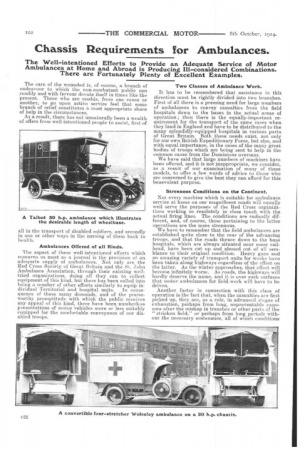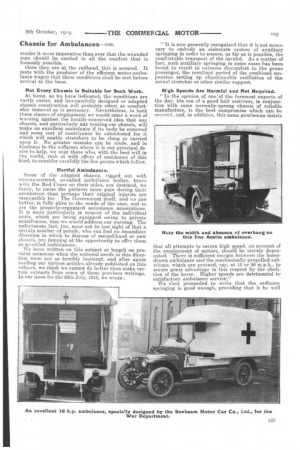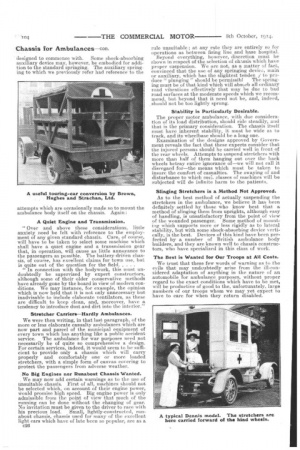Chassis Requirements for Ambulances.
Page 8

Page 9

Page 10

If you've noticed an error in this article please click here to report it so we can fix it.
The Well-intentioned Efforts to Provide an Adequate Service of Motor Ambulances at Home and Abroad is Producing Ill-considered Combinations. There are Fortunately Plenty of Excellent Examples.
The care of the wounded is, of course, a branch of endeavour to which the non-combatant public can readily and with fervour devote itself in times like the present. Those who are unable, from one cause or another, to go upon active service feel that some branch of relief constitutes a most appropriate share of help in the circumstances.
As a result, there has not unnaturally been a wealth of offers from well-intentioned people to assist, first of all in the transport of disabled soldiers, and secondly in one or other ways in the nursing of them back to health.
Ambulances Offered of all Kinds.
The aspect of these well-intentioned efforts which concerns us most as a journal is the provision of an adequate supply of ambulances. Not only are the Red Cross Society of Great Britain and the St.. john Ambulance Association, through their existing welltried organizations, doing all they can to collect equipment of this kind, but there has been called into being a number of other efforts similarly to equip in
dividual Territorial and hospital units. In consequence of these many demands, and of the praiseworthy promptitude with which the public receives any appeal of this kind, there have been numberless presentations of motor vehicles more or less suitably equipped for the comfortable conveyance of our disabled troops. Two Classes of Ambulance Work.
It has to be remembered that assistance in this direction must be rightly divided into two branches. First of all there is a pressing need for large numbers of ambulances to convey casualties from the field hospitals down to the bases in the actual areas of operation ; then there is the equally-important requirement for the transport of the same cases when they land in England and have to be distributed to the many splendidly-equipped hospitals in various parts of Great Britain. Both these needs exist, not only for our own British Expeditionary Force, but also, and with equal importance, in the cases of the many great bodies of troops which are being .sent to help in the common cause from the Dominions overseas.
We have said that large numbers of machines have been offered, and it is not inappropriate, we consider, as a result of our examination of many of these models, to offer a few words of advice to those who are concerned to give the best they can afford for this benevolent purpose.
Strenuous Conditions on the Continent.
Not every machine which is suitable for ambulance service at home on our magnificent roads will equally well serve the purposes of the Red Cross organitations working so resolutely in close touch with the actual firing lines. The conditions are radically different, and, of course, those pertaining to the latter operations are the more strenuous. We have to remember that the field ambulances are established quite close to the rear of the advancing troops, and that the roads thence down to the base hospitals, which are always situated near some railhead, have been cut up and abused out of all semblance to their original condition. Heavy guns and an amazing variety of transport units for weeks have been taken along highways regardless of the effect on the latter. As the winter approaches, that effect will become infinitely worse. As roads, the highways will hardly deserve the name, and it is over such surfaces that motor ambulances for field work will have to be driven.
Another factor in connection with this class of operation is the fact that, when the casualties are first picked up, they arc, as a rule, in advanced stages of exhaustion, perhaps from long, unpreventable exposure after the mishap in trenches or other parts of the "stricken field," or perhaps from long periods without the necessary sustenance, all of which conditions render it more imperative than ever that the wounded men should be carried in all the comfort that is humanly possible.
Once they are at the railhead, this is assured. It rests with the producer of the efficient motor-ambulance wagon that these conditions shall be met before arrival at the base.
Not Every Chassis is Suitable for Such Work.
At home, as we have indicated, the conditions are vastly easier, and less-carefully designed or adapted chassis construction will probably etfect as comfortable removal as is necessary. Nevertheless, in both these classes of employment we would utter a word of warning against the hastily-conceived idea that any chassis, and particularly any touring-car chassis, will make an excellent ambulance if its body be removed and some sort of contrivance be substituted for it which will enable stretchers to be slung or carried upon it. No greater mistake can be made, and in kindness to the sufferers whom it is our principal desire to help, we urge those who, with the best will in the world, rush in with offers of assistance of this kind, to consider carefully the few points which follow.
Hurtful Ambulances.
Some of the adapted chassis, rigged out with canvas-covered, so-called ambulance bodies, bravo with the Red Cross on their sides, are destined, we fancy, to cause the patients more pain during their occupation than perhaps their original injuries are responsible for. The Government itself, and no one better, is fully alive to the needs of the case, and so are the properly-organized ambulance associations. It is more particularly in respect of the individual units, which are being equipped owing to private munificence, that we would address our warning. The unfortunate fact, too, must not be lost sight of that a certain number of people, who can find no immediate direction in which to dispose of second-hand or new chassis, are jumping at the opportunity to offer them as so-called ambulances.
We have written on this -subject at length on previous occasions when the national needs in this direction were not so terribly insistent, and after again reading our various articles already published on this subject, we think we cannot do better than make certain extracts from some of these previous writings. In our issue for the 25th July, 1912, we wrote : " It is now generally recognized that it is not necessary to embody an elaborate system of auxiliary springing in order to ensure, as far as is possible, the comfortable transport of the invalid. As a matter of fact, such auxiliary springing in some eases has been found to result in extreme discomfort to the prone passenger, the resultant period of the combined suspension setting up objectionable oscillation of the actual stretcher or other similar support.
High Speeds Are Harmful and Not Required.
" In the opinion of one of the foremost experts of the day, the use of a good hair mattress, in conjunction with some normally-sprung chassis of reliable manufacture, is the best compromise which can be secured, and, in addition, this same gentleman insists
that all attempts to secure high speed, on account of the employment of motors, should be sternly deprecated. There is sufficient margin between the horsedrawn ambulance and the mechanically-propelled substitute, which can proceed, say, at 15 or 20 m.p.h., to secure great advantage in this respect by the abolition of the horse. Higher speeds are detrimental to satisfactory ambulance service." We then proceeded to write that the. ordinary springing is good enough, providing that it be well designed to commence with. Some shock-absorbing auxiliary device may, however, be embodied for addition to the standard springing. The auxiliary springing to which we previously refer had reference to the attempts which are occasionally made so to mount the ambulance body itself on the chassis. Again A Quiet Engine and Transmission.
"Over and above these considerations, little anxiety need be felt with reference to the employment of any given standard chassis. Care, of course, will have to be taken to select some machine which shall have a quiet engine and a transmission gear that, in operation, will cause as little annoyance to the passengers as possible. The battery-driven chassis, of course, has excellent claims for town use, but is quite out of the question for the field
In connection with the bodywork, this must undoubtedly be supervised by expert constructors, although some of their older conservative methods have already gone by the board in view of modern conditions. We may instance, for example, the opinion which is now held that it is not only unnecessary but inadvisable to include elaborate ventilators, as these are difficult to keep clean, and, moreover, have a tendency to introduce dust and dirt into the interior."
Stretcher Carriers—Hardly Ambulances.
We were then writing, in that last paragraph, of the more or less elaborate casualty ambulances which are now part and parcel of the municipal equipment of every town which has anything like a public accident service. The ambulance for war purposes need not necessarily be of quite so comprehensive a design. For certain services, indeed, it would seem to be sufficient to provide only a chassis which will carry properly and comfortably one or more loaded stretchers, with a simple form of canvas covering to protect the passengers from adverse weather.
No Big Engines nor Runabout Chassis Wanted.
We may now add certain warnings as to the use of unsuitable chassis, First of all, machines should not be selected which, on account of their engine power, Would promise high speed. Big engine power is only admissible from the point of view that much of the running can be done without the changing of gear. No invitation must be given to the driver to race with
his precious load. Small, lightly-constructed, runabout chassis, chassis used for many of the excellent light cars which have of late been so popular, are as a c26
rule unsuitable ; at any rate they are entirely so for operations as between firing line and base hospital. Beyond everything, however, discretion must be shown in respect of the selection of chassis which have proper suspension. We are not, as a matter of fact, convinced that the use of any springing device, main or auxiliary, which has the slightest tenden y to pro
duce " plunging " should be permissibl The springing must be of that kind which will absorb all ordinary road vibrations effectively that may be due to bad road surfaces at the moderate speeds which we recommend, but beyond that it need not be, and, indeed, should not be too lightly sprung.
Stability is Particularly Desirable.
The proper motor ambulance, with due consideration of its load distribution, should ride steadily, and that is the primary consideration. The chassis itself must have inherent stability, it must be wide as to track, and its wheelbase should be a long one.
Examination of the designs approved by Government reveals the fact that these experts consider that the injured persons should be carried well in front of the rear wheels. Attempts to suspend stretchers with more than half of them hanging out over the back wheels betray entire ignorance of—we will not call it disregard for—the means which must be taken to insure the comfort of casualties. The swaying of and disturbance to which suel, classes of machines will be subjected will do infinite harm to the patients.
Slinging Stretchers is a Method Not Approved.
As to the best method of actually suspending the stretchers in the ambulance, we believe it has been definitely settled by those who know best that a method of slinging them from uprights, although easy of handling, is unsatisfactory from the point of view of the wounded passenger. Some method of mounting which supports more, or less rigidly as to lateral stability, but with some shock-absorbing device vertically, is the best. Devices of this kind have been perfected by a number of British ambulance body builders, and they are known well to chassis constructors, who have specialized in this class of work.
The Best is Wanted for Our Troops at All Costs.
We trust that these few words of warning as to the evils that may undc-abtedly arise from the ill-considered adaptation of anything in the nature of an automobile for ambulance purposes, without proper regard to the exact conditions which have to be met, will be productive of good to the, unfortunately, large numbers of our troops whom we may yet expect to have to care for when they return disabled.




















